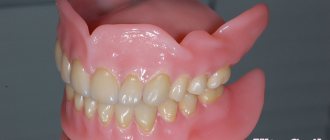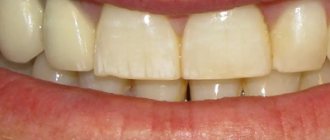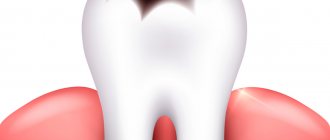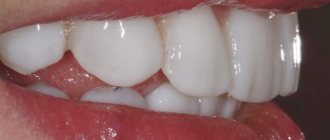The Smile-at-Once clinic uses new generation composites - increased strength using nanoparticles. Despite the fact that they are stronger than classical materials, the patient in any case needs to follow the rules for caring for the extended teeth.
Extensions are very similar to regular fillings, since the same materials are used. Therefore, the rules of care are largely similar. However, there are also differences - artistic restoration is carried out in a more elaborate manner, since a small piece or even a whole crown is built up. The composite is fixed on top, and not placed inside the cavity, so the absence of walls imposes certain obligations in terms of caring for such teeth.
How much should you not eat after teeth extensions?
Since anesthesia is used for recovery, you should avoid eating for 2-3 hours after the end of treatment. You need to wait until the numbness goes away completely, otherwise you may accidentally bite your lip, tongue or cheek while chewing.
Modern photopolymer dental fillings harden under the influence of a special lamp almost instantly, so the load on them will not lead to shrinkage of the material - if anesthesia was not used, you can eat right away. But it is better to give preference to softer and warmer foods.
If the tooth has been significantly damaged and a pin or stump insert was used as additional support, you should avoid eating hot or very cold food for the first 24 hours, since special dental cement was used - its fixing properties may become worse under temperature stress.
Contraindications to the procedure
In some cases, you have to postpone it for a certain time or completely abandon this idea. Restrictions can be temporary or absolute. The first includes:
- insufficient level of oral hygiene;
- inflammatory processes;
- periodontal diseases;
- malocclusion;
- significant destruction of the dental unit;
- diseases of the jaw joint.
These shortcomings can be eliminated. The presence of metal-ceramic crowns at the site of the proposed restoration completely rejects the idea of restoration with a composite or ceramic, since these materials are incompatible, and the result of the efforts will be short-lived. Also, dentists at the Dentika clinic do not recommend installing veneers and lumineers for bruxism and pathological tooth wear.
What dietary restrictions are there after dental restoration?
Modern composites, even despite their high performance characteristics, are susceptible to staining, which is why even if the filling is in good condition, after a few years it becomes darker compared to natural enamel. Over time, a clear contrast will be felt between the living tooth and the extended piece.
Extended teeth are quite weak - under load, a piece of filling material can break off. Especially when carrying out restoration of the frontal zone. All this requires following a certain diet.
- coffee, tea, red wine, sweet colored soda, beets, sauces (especially tomato and soy), berries, candies and caramel are not recommended - that is, all products that over time will lead to a change in the shade of the extension,
- Avoid eating solid vegetables and fruits whole - it is better to cut them into pieces and chew them with unextended teeth. This is especially true if the front teeth have been restored - they should not bite off hard foods, gnaw seeds,
- give up the habit of cracking nuts or cracking seeds, gnawing crackers with extended teeth,
- Chew food slowly, especially if it is hard or fibrous,
- Avoid food that is too hot or cold - it can cause cracks and chips in the material.
If women have extended front teeth, it is better to avoid bright lipsticks, since composites can again become stained.
What is the best material to make restorations of anterior teeth from? Ceramics vs. light seals...
As a small survey on my website showed, many of us will definitely go to the dentist only if we suddenly notice a deterioration in the appearance of our front teeth. But who should I go to? To a therapist so he can install a light filling? Or to a prosthetist to make a ceramic veneer? The questions are actually difficult and ambiguous... Even dentists often break their spears in disputes about what is best to do and when... What can we say about patients then! I will try to talk about the pros and cons of both light fillings and ceramic restorations . Well, let’s try to understand the indications for both.
The division of dentists in our country into “therapists” and “orthopedists” often creates situations where doctors unjustifiably juggle indications for choosing one or another restoration technique. Simply put, they choose not what will be optimal for the patient, but what they can do. Or worse, what's better for their pocket. In this case, an orthopedist can sharpen a barely damaged tooth for a crown or veneer because he does not know how to use filling material. And the therapist will sculpt a huge filling for the entire tooth, because he does not know how to take impressions to make a crown or ceramic veneer . Referring a patient to a colleague means losing money. In our hyper-materialistic times, and even in conditions of fierce competition, not all dentists will put the needs of the patient at the forefront in such a situation. The division of inseparable, in my opinion, skills and abilities is a big problem in our dentistry. Especially the state one. Well, yes, God bless her. Why did I write this? In large ministerial offices with expensive furniture, they are clearly not thinking about how to make our life more correct and easier. And therefore, friends, you will have to understand some of the intricacies of the process yourself. And in controversial situations, try to hear the opinion of both the “therapist” and the “orthopedist”. Well, my article will help you.
So. Let us briefly examine how a filling from a light composite is made. In order not to repeat myself, I discussed the entire modern restoration protocol in the article “Treatment of caries.” It is the same for any teeth. But when restoring the front ones, you need to remember some nuances.
Composites for filling fillings, even the coolest and most modern ones, are mostly plastic. A number of disadvantages follow from the properties of this material:
— instability of restoration over time. This applies to both color and shape. When we eat and brush our teeth, we mechanically constantly act on the filling material. It slowly gets scratched, loses its shine (even if the dentist initially polished it well), becomes dull and rough. This leads to plaque retention on its surface. At the same time, under the influence of dyes from food (or, for example, when smoking), such a matte surface also quickly darkens, revealing the presence of restoration to everyone around.
— low mechanical strength quickly enough (within 5-7 years maximum) leads to the appearance of microchips of the composite and disruption of the seal’s fit to the tooth. This can cause a cosmetic defect in the form of a stained strip between the filling and the tooth, and the re-development of caries.
— many composite filling materials do not have sufficient similarity in optical properties to natural tooth tissues. As a result, no matter how hard the doctor tries, the restored area will differ in appearance (color, degree of transparency, surface texture) from healthy tissue. Not all patients will be satisfied with such aesthetics, which, moreover, will only worsen over time.
- lack of normal fluorescence in many materials. This can lead to the fact that at a disco in ultraviolet light, all your fillings on your front teeth will look like a kind of “black holes”, which will not give your smile any special beauty.
That's probably enough about the main disadvantages. Now we can’t help but talk about the advantages of light fillings for the restoration of front teeth.
- ease and speed of use. An hour and a half in the doctor's chair - and everything is ready. To manufacture ceramic restorations, it is necessary to take impressions and involve a dental laboratory. This increases the time. You need at least two visits, but in fact, with all the fittings, you often end up with more. In addition, this naturally affects the cost. The price of a ceramic veneer is usually at least 2-3 times higher than the cost of a light filling . Hence its next advantage...
- relative cheapness;
- high maintainability. Those. If a ceramic veneer chips, you will have to completely remove it and redo it. If a composite restoration breaks, you can easily put a “patch” on the problem area.
- less aggressive tooth treatment. When placing a new light filling, the doctor, preparing the tooth for restoration, removes only old fillings and carious tissue. Nothing extra. When making ceramic restorations, it is often necessary to remove some healthy tissue.
We've sorted out the pros and cons... now I propose to move from theory to practice. And using several real clinical cases, we will consider the above-described properties of light fillings and ceramic restorations.
This photo shows multiple composite fillings and veneers on upper anterior teeth approximately 2 years after fabrication. The black arrow shows how the filling on tooth 21 stands out. The difference is emphasized by the brown-painted border between the filling and the tooth. The blue arrow marks tooth 11, on which a composite filling covers the entire front surface. It is monochromatic, matte, so it obviously doesn’t look very good aesthetically. In addition, in the cervical part, due to a violation of the marginal seal, there is recurrent caries (a brown strip along the gum). The green arrow indicates a canine (tooth 13), on which the same composite veneer has completely fallen off. Which, by the way, was initially the main reason for the patient’s contact with me.
Overall... a depressing sight just a couple of years after treatment. Of course, this case is not an example of high-quality work with composite materials. But the indications for their use are clearly exceeded here.
Next example...
The green arrow in this photo illustrates that after some time the composite light filling can move away from the edge of the tooth, opening the way for microflora in its “insides”. This can happen especially quickly with increased load on the tooth and poor hygiene. In general, poor hygiene and composites are poorly compatible things. The black arrow shows the area of the tooth restored with a filling and noticeably different in color and degree of transparency from the surrounding tissues.
Another case...
These composite “restorations” are also no more than 5 years old. Here you can clearly see how over time they lose their smoothness, begin to accumulate plaque, and are stained with food dyes. As a result, the most visible front teeth have such a deeply sad appearance. Black arrows show areas that clearly differ in the degree of shine from the tissues of your own tooth. This is because composite materials are not able to maintain a polished, smooth appearance for a long time. The green arrow indicates a conventional plastic crown, which this patient also had for about 5 years. Its appearance shows that ordinary plastic and composite are related in chemical nature. They look approximately the same in operation. Equally bad... and the longer they last, the worse the appearance becomes. In addition, the monotony and lack of natural translucency characteristic of our natural teeth are clearly visible.
And finally, the last case is an illustration of exceeding the indications for the use of light composites in the restoration of anterior teeth...
To what has already been said and shown above (dull surface, chips, staining of borders), we can add the indicative fact of plaque accumulation at the border between the composite filling and the tooth. The matte surface, devoid of polished gloss, also helps to retain plaque and make it difficult to remove when brushing your teeth. The result is chronic gingivitis and recurrent caries along the border between the filling and the tooth. All this is shown by black arrows - the gums are red, swollen, and bleed when touched. These fillings are also about 2 years old... nothing at all.
Now let's take a closer look at ceramic restorations; we will mainly talk about ceramic veneers.
I already talked about this clinical case of front teeth prosthetics a little earlier.
Here, in addition to the need to prosthetize a missing tooth using a crown on an implant, it was important to eliminate the corner defect on the neighbor and increase its width (you can read the link for why and why this was necessary). The dotted line shows the contours of the required “extension” of the tooth. In this situation, a light seal could also be used. But it would have to cover almost half a tooth. And you have already seen what massive composite restorations look like after a few years... In addition, the crown on the implant was made of ceramics. As a result, we would get dissimilar materials standing nearby in one place - ceramics, composite and natural tooth tissue. Not only is it not always a feasible task to fit dissimilar materials into a single form. But the most important thing is that over time, due to the aging of the composite, the difference in appearance would definitely become very noticeable. If we add to this the high demands of the female patient on aesthetics, then the choice is obvious - ceramic veneer. Which is what was done.
Here you can see that to make the veneer, we had to process not only those places where tooth extension was directly required, but also where it was not required. As I said, tooth treatment for ceramic restoration is almost always more aggressive. It must be said that the thickness of the tissue removed is minimal (about 0.5-0.8 mm). A beautiful and most importantly long-term result requires some sacrifices.
The final result speaks for itself. And there is no doubt that these teeth will look the same a year, and 3, and 5 years later... And if you don’t believe me, then look further.
Another illustrative case... Let's compare the appearance of ceramic veneers 3.5 years after their manufacture with what we saw in cases with light fillings.
Initial situation. Lower incisors, increased abrasion (which indicates increased stress) and poor hygiene. The conditions are quite similar to those we saw in the first photographs with composite restorations. We have already seen how light seals serve in such conditions. What about ceramics?
This is what the teeth looked like on the day the ceramic veneers . The teeth became lighter, smoother, with a natural surface texture and translucency. After polishing the margins, slight trauma to the gums is noticeable. What happened to them after 3.5 years?
But nothing... The teeth look as if the patient and I parted just yesterday. True, not only the appearance of the teeth remained unchanged, but also some of the young man’s neglect of hygiene. With all this, pay attention only to a slight brown coating on the neck of the teeth. It was easily removed in 1 minute with a brush and paste. In this case, it is worth paying attention to the appearance of the ceramics. It has absolutely lost neither shine nor color. The gums around the teeth are absolutely healthy. And we don’t see a single chip. But with such hygiene and dental restoration with composite light fillings, the appearance of this patient’s teeth and gums would be completely different... so, as they say, feel the difference! Unchangeable appearance and long service life are the main advantages of ceramics over composites.
***You can read more about this clinical case of restoration of front teeth with ceramic veneers at the link.
And one more visual illustration. If I really wanted to, I could be accused of showing poorly executed light fillings and comparing them with well-made ceramics. The next case should put everything in its place. The author of the work and photographs is Dr. Sergey Maksimov (Moscow).
This clinical case clearly demonstrates the replacement of “artistic cosmetic restorations” made of composite with ceramic veneers. Here it must be said that the composite “arts” are made quite decently and accurately. But... a composite is a composite. After a short time, we see all the delights of its use - dullness, monotony of the teeth, and problems with the fit of fillings in the cervical part of the teeth. Well, you can clearly see what replacing the composite with ceramics gave this patient.
The same work, but on the lower jaw. Numerous chips, dullness, accumulation of plaque in the cervical area (green arrow), inflamed gums... All this happened with composite. And all this disappeared when it was replaced with ceramics. A very clear result.
So, are light fillings really that bad and there is no use for them in the aesthetic restoration of anterior teeth? No, that's definitely not the case. And here is the last example from my own practice.
In this case, the girl came in with a front tooth injury. What we see in the photo is a small chip in the corner and cutting edge. At the same time, excellent hygiene, intact (i.e., unharmed) neighboring teeth, correct bite. In this case, the right place is for a small cosmetic filling made of composite.
The final result, with proper skill in handling the composite material, can be no worse than ceramic restorations in aesthetic terms. At the same time, one of the best materials for artistic restoration, Enamel HFO, was used, which has a wide selection of colors and shades. It allows the doctor, literally like an artist, to apply different shades with a brush, imitating any natural features of color, transparency and other characteristics of our teeth. And at the same time, such a restoration will still require periodic polishing to maintain its original shine. In addition, the area of “gluing” of the composite filling with the tooth is very small, and the load on this area of the tooth is large (it is with the cutting edge of the central incisors that we bite off food). This means that such a tooth will now have to be handled with care.
It's time to draw conclusions. All the clinical cases I showed confirm what I wrote about at the very beginning. Every technology and every material has the right to life, the most important thing is the indications. I don’t pretend to be the truth, but I’ll try to determine where what works better.
Your choice is a ceramic veneer if:
– damage to the front tooth affects more than 1/3 of the visible surface
- you are demanding of aesthetics
— you want the restoration to serve without problems for more than 5 years without losing its appearance
- you have damaged the cutting edges of the entire frontal group of teeth due to pathological abrasion (well, or any other damage to several front teeth at once)
Your choice is a light seal if:
— the tooth defect is minor (less than 1/3) or is out of sight
- you have excellent hygiene
— Are you ready to go every six months to a year to polish the filling?
— Are you ready to change it every 5 years (on average)
— You need temporary restoration
— You need an inexpensive restoration
— You are not very picky about the appearance of your front teeth
Of course, these are just general recommendations. We must not forget about what your particular dentist can offer, what he is better at, what he does better. Although, ideally, any technique and material should be equally accessible to him. Only then will he be able to offer the best solution specifically for your situation. And now you can consciously approve of it... or refuse.
How to do oral hygiene
If it is impossible to refuse drinks and foods that stain filling materials, you need to pay increased attention to hygiene. In such situations, cleaning after every meal is mandatory.
- cleaning in the morning and evening (before and after breakfast, as well as after the last meal) with a medium-hard brush,
- irrigator, dental floss, brushes and rinse for cleaning the interdental spaces after each meal and even after a regular snack.
To whom is the technique contraindicated?
Artistic restoration of teeth with composite material is not possible for all clients, since the technique has a number of contraindications (some of them are temporary and correctable):
- Allergic reaction to the composite;
- Installed pacemaker;
- Some individual characteristics that prevent the sealing of a carious cavity;
- Poor oral hygiene;
- Night grinding of teeth (bruxism);
- Pathological bite;
- Excessive abrasion of tooth enamel;
- Frequent stay in traumatic conditions (athletes, rescuers, etc.).
By registering with Nurimed, clients can be calm about their own safety and the results of the procedure, since the clinic’s doctors individually assess the risks and benefits for everyone.
Does the restoration need to be changed and when might it be necessary?
On average, the service life of composite extensions is about 3-5 years. Such a filling may last longer, but it will stand out on the front teeth after 3-4 years. Composites shrink, albeit slightly, so over time a small step will appear between the tooth and the filling material. This is especially noticeable on the front teeth if they are partially restored. In such a situation, you can update the restoration, that is, completely grind it down and replace it with a new one. Or simply re-build it up with a composite on top - in certain situations this is also allowed.
Composite veneers: installation method, advantages, indications
Composite veneers are the second name for aesthetic dental restoration performed using modern microphilic compounds. The doctor applies the filling material to the surface of the damaged or defective tooth and creates the ideal anatomical shape of the unit immediately in the patient’s mouth. After polishing, the restored tooth is indistinguishable from neighboring incisors and canines.
Since real-time tooth restoration requires high professionalism and experience from the dentist, it is necessary to look for doctors who have been involved in artistic restoration with composite materials for a long time. The best selection criterion will be patient reviews and independent rating indicators.
When are composite veneers recommended?
Indications for restoration with filling material are determined by the properties of the compositions used - strength characteristics and durability indicators. The aesthetics of the tooth can be easily restored in cases of minor changes in the shape, shade or position of the anterior units:
- Small chips along the edges.
- Moderate-sized interdental gaps.
- Teeth extension with physiological abrasion.
- Change in enamel color.
In other cases, the use of classic indirect veneering or the installation of ceramic crowns is indicated.
Classification of disease prevalence
With local abrasion, only individual teeth are affected - as a rule, against the background of some acquired factors; with generalized abrasion, this problem already affects the entire dentition, and such an anomaly is usually congenital.
Symptoms of increased tooth wear
- the appearance of tooth enamel changes, it becomes uneven, rough, and tubercles appear on it;
- the natural color of the teeth changes, they become almost translucent;
- teeth acquire increased sensitivity to the effects of cold and heat, to mechanical or chemical irritants;
- sharp edges form on the enamel, which can injure the mucous membrane on the inner surface of the lips and cheeks;
- the teeth are shortened, the lower third of the face decreases in size, and folds appear in the corners of the mouth;
- hearing loss occurs and the chewing process is disrupted.
Pros and cons of direct veneers
- The main advantage of composite veneers over ceramic ones is, first of all, price. Composite veneers do not require complex installation technology and expensive materials, so prices in aesthetic dentistry are low.
- Another benefit of composite overlays is the time it takes to install them. Therapeutic veneering is possible in one visit, as it does not require taking impressions and making plates in a dental laboratory. But this advantage is not always relevant, since technologies have appeared that make it possible to install ceramic veneers in one day.
- Reviews of the installation of composite veneers indicate that they cope well with irregularities, chips, cracks and large gaps between teeth, but they do not imitate the natural color and transparency of enamel as perfectly as ceramic ones.
- The main disadvantage of composite veneers is their imprecise fit to the tooth surface, which is why plaque and bacteria accumulate in border areas, increasing the risk of caries and gum inflammation.
- The doctor is required to have aesthetic taste and excellent skill, otherwise the result will not live up to expectations.
Materials used
The cost of dental restoration directly depends on the materials used. Extension on a pin involves implanting a rod made of titanium, steel or fiberglass into the bone tissue. The first material enjoys well-deserved popularity due to its unique combination of low weight, amazing strength, and environmental safety. The alloy, widespread in various areas of the national economy, integrates perfectly into the oral cavity without causing side effects. Surgical steel is an equally common material for dental restoration, characterized by high resistance to mechanical and thermal stress. As for fiberglass, recently the carbon variety of nanomaterial, which has the ability to adapt to the structure and behavior of the patient’s soft tissues and evenly distribute chewing loads, has become increasingly in demand. When restoring teeth using traditional methods using crowns, various materials are also used.
- Ceramics are an aesthetically beautiful solution that provides a snow-white smile and an attractive appearance. It requires careful care, is highly fragile and does not have a very long lifespan.
- Metal is an obsolete material that is currently almost never used. However, in terms of strength characteristics it surpasses its competitors, so products made from alloys are still in demand.
- Metal-ceramics is an intermediate and most successful option. Combines the attractiveness of the first and the reliability of the second material. The affordable price explains the high demand for metal-ceramic crowns.
FACT! Ceramics and metal ceramics, due to the addition of useful microelements and a tight fit, provide reliable protection of units from pathogenic microbes. Therefore, dentists consider ceramic crowns and veneers not only an effective aesthetic solution, but also a powerful preventive measure. According to doctors, people with such structures in their mouths after dental restoration are less likely to develop superficial, medium and deep caries.
Composite restoration techniques
Restoration with composite veneers has several techniques that are essentially similar.
Indirect composite veneers - compositors
Componeers, like direct composite veneers, are used to correct the color and shape of teeth. But they are made not according to individual casts, but according to templates, and are offered to the patient in finished form. The overlays, formed from extruded composite, are installed using the indirect method. The structure lasts 5 - 7 years. You can learn more about the methodology here.
Restoration with composite veneers instead of bleaching
Restorative bleaching, or lamination, is the application of a thin layer of composite to the tooth surface. Unlike restoration with composite veneers, plates only change the color of the teeth without affecting the shape.
Artistic restoration
The technique of artistic restoration involves the correction of dental surfaces with composites for chips, cracks, irregular shapes and other aesthetic defects. The technology is similar to installing composite veneers on teeth. However, the procedure is carried out in both the frontal and chewing areas. Filling also applies to this technique.
Cost of procedures
Prices for dental extensions vary depending on:
- Number of units restored.
- Severity of the defect.
- The chosen extension technique.
- Materials used.
The cost is also affected by the condition of the oral cavity, the preservation of the tooth root, the need for preliminary sanitation and other procedures. The final price of services is determined after examination by the dentist. The patient can influence the final cost by choosing more affordable composites and restoration technologies.
Regardless of the chosen technique, the doctors at the Ulybka dental clinic guarantee their patients beautiful and long-lasting results. Our specialists have extensive experience in building extensions of varying complexity, have modern tools and use advanced materials to ensure a highly aesthetic result.
You can find out the cost of extension of front and back teeth in Yoshkar-Ola in our price list.









